|
Related FAQs: Marine Life
of the Tropical West Atlantic, Tropical West Atlantic 2,
Related Articles: TWA
Invertebrates, Algae, Vascular Plants, Introduction to Fishwatcher's Guide
Series Pieces/Sections, Lachnolaimus maxiumus/Hogfish, Hogfishes of the Genus
Bodianus,
Fishes of The Tropical West
Atlantic: Bahamas to Brazil, Part 10
To: Part 1, Part 2, Part 3,
Part 4, Part
5, Part 6, Part 7, Part 8,
Part 9, Part
11,
|
|
| Bob Fenner |
|
The, Tangs, Surgeons, Family Acanthuridae. The TWA is
depauperate (i.e. scant) on many groups of animals compared with the
more speciose Pacific and Indian Oceans. Acanthurids follow this
characteristic, with only three species (there are 24 in Hawai'i.).
The only one used for commercial purposes is the (Atlantic) Blue Tang,
Acanthurus coeruleus (2), as gorgeous, but diminutive yellow young,
turning azure blue with age. The other couple of species, the Bahamian
Surgeonfish (A. bahianus) (2) and Doctorfish, (A. chirurgus) (2) do as
well in captivity, but are more somber and get quite large (about
14"). For big tanks only.
Ecotype: Roam shallow to mid-depth reefs searching for algal
food
| Acanthurus bahianus
Castelnau 1855, the Ocean Surgeon, ranges widely over the western
Atlantic coast. It's a shame this hardy fish isn't more
often sold in the trade; it has a quiet, yet strong beauty.
Although not super-gorgeous it is one of the least aggressive
Acanthurus, and readiest feeder on aquarium fare. Two views
in the Bahamas. |
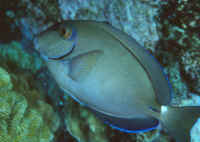 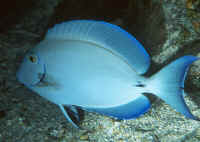
|
|
Acanthurus chirurgus (Bloch 1787), a/the
Doctorfish; from the western Atlantic. Bluish to brownish in
color, and though common in the wild, rarely offered in the
trade. Bonaire and Bahamas pix.
|
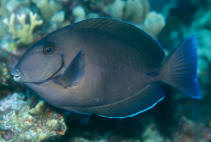 
|
| Acanthurus coeruleus Bloch
& Schneider 1801, the Atlantic Blue Tang; though not as
dazzlingly beautiful as the other two "Blue Tangs"
(Paracanthurus hepatus & Acanthurus leucosternon)
this Caribbean surgeon makes a fine aquarium addition. One of a
handful of Acanthurus that are overall yellow as juveniles,
the Atlantic Blue Tang stays small enough for modest sized
aquariums. |
 |
 |
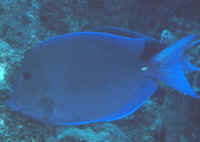 |
|
Acanthurus coeruleus (Juvenile)
|
Acanthurus coeruleus (Midsize.)
|
Acanthurus coeruleus (Adult)
|
Balistidae, the Triggerfishes. Here again, the TWA has a
handful (okay plus one, 6) of species with only one used commercially.
This is the equally beautiful and antagonistic Queen Trigger, Balistes
vetula (1). Of the others the Sargassum (Xanthichthys ringens) (2) and
Black Durgon (Melichthys niger) (2) ought to be more utilized.
They're "medium" easy-going on the trigger scale, and
only get about a foot long.
Ecotype: Like the joke about the 800 pound gorilla; "where do
they live?" Anywhere they want. Actually these triggers inhabit
low areas around reefs where they can quickly duck into hiding.
|
Much more beautiful but the embodiment of aggression in a marine
tropical is the Queen Triggerfish, Balistes vetula
Linnaeus 1758, from the Atlantic. This is a MEAN fish,
biting machine that must be kept with basses, puffers and other
animals too unpalatable to bite or mean and smart enough to bite
back. To two feet in length. Pictured below: A two inch
"tiny" specimen, a fifteen inch monster in captivity,
and a foot long beauty in the Bahamas.
|
| Balistes capriscus (nee carolinensis)
Gmelin 1789, the Grey Triggerfish. East and West coasts of the
Atlantic. To two feet in length. Feeds on benthic invertebrates;
mollusks, crabs. As B. capriscus in some literature. |
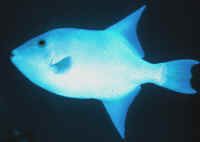
|
| Canthidermis maculatus (Bloch 1786), the
Spotted Oceanic Triggerfish. Circumglobal. To twenty inches in
length. A pelagic species that adapts poorly to captivity in
general. To about a foot and a half in length. |
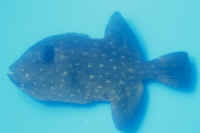
|
| Another all-gray contender is the tropical West
Atlantic Ocean Triggerfish, Canthidermis sufflamen (Mitchell
1850). This is another candidate for regional Public Aquariums with
space to spare. To twenty six inches in length. Open ocean species.
Bahamas pic. |
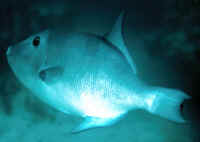
|
| Most wholesalers offer two species of Melichthys
more or less continuously, the circumtropical Black (Durgon)
Triggerfish, Melichthys niger (Bloch 1786) (usually out of
Hawai'i), to eighteen inches. Pictured: an individual in
the Bahamas, and one in Maui, Hawai'i. |
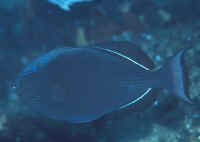 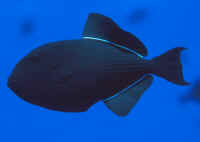
|
| The Blue Cheekline or Sargassum Xanthichthys
ringens (Linnaeus 1758) from the Atlantic Triggers. These
pelagics adapt more poorly to captivity than other trigger species.
Tropical west Atlantic, North Carolina to Brazil. This one in the
Bahamas. |
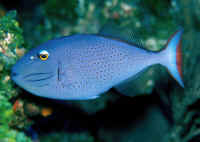
|
Filefishes, Family Monacanthidae. Rarely are filefishes of
the TWA put to use, and this is a shame for three of the species. The
Scrawled file, Aluterus scriptus (3) is found worldwide and collected
for the trade elsewhere (though it gets to three feet long); and the
Orangespotted File (Cantherhines pullus) (2) and Whitespotted File (C.
macrocerus) (2) are good looking and can be kept in captivity.
Ecotype: The Scrawled File lives above the reef to open oceans; the
two others are more homebodies, living in shallow to mid-depths near
the bottom.
| Aluterus schoepfii (Walbaum 1792), the
Orange Filefish. East and West coasts of tropical Atlantic and Gulf
of Mexico. To two feet maximum length. Aquarium images. |
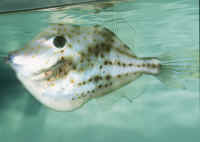 
|
| Aluterus scripta (Osbeck 1785), the Scrawled
Filefish. Circumtropical. Sold in the trade occasionally, but gets
way too big. Shown a tiny one foot specimen and a two foot
youngster (Bunaken/Indonesia and Red Sea respectively) (to forty
inches overall length). |
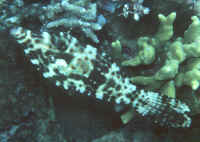 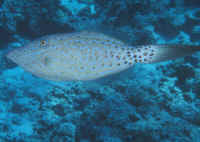
|
| Cantherhines macrocerus (Hollard 1854), the
Orange Filefish in the pet trade is called the American
Whitespotted Filefish in the sciences... unfortunately, in part
because it occurs on both coasts of the tropical Atlantic. One of
the more common Filefish offerings in the world of aquariums. To
twenty-six inches in length. Images of six inch and eight inch
individuals and one foot adult specimens in the Bahamas. |
| Cantherhines pullus (Ranzani 1842), the
Orange-spotted Filefish. Tropical West Atlantic. To eight inches in
length. A more common aquarium offering. One off the Bahamas,
another with its single dorsal "trigger" up off Boynton
Beach, FLA. |
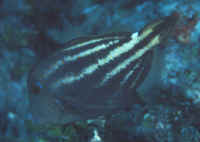 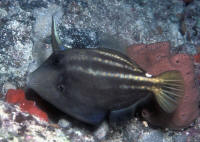
|
| Monacanthus tuckeri Bean 1906, the Slender
Filefish. Western Atlantic; North Carolina to the Antilles. To four
inches in length. This three quarter inch juvenile hanging out in a
gorgonian in the Bahamas. |
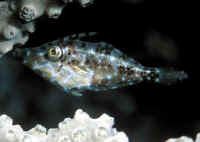
|
To: Part 1, Part
2, Part 3, Part
4, Part 5, Part
6, Part 7, Part
8, Part 9, Part
11,
|
|

